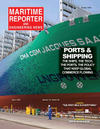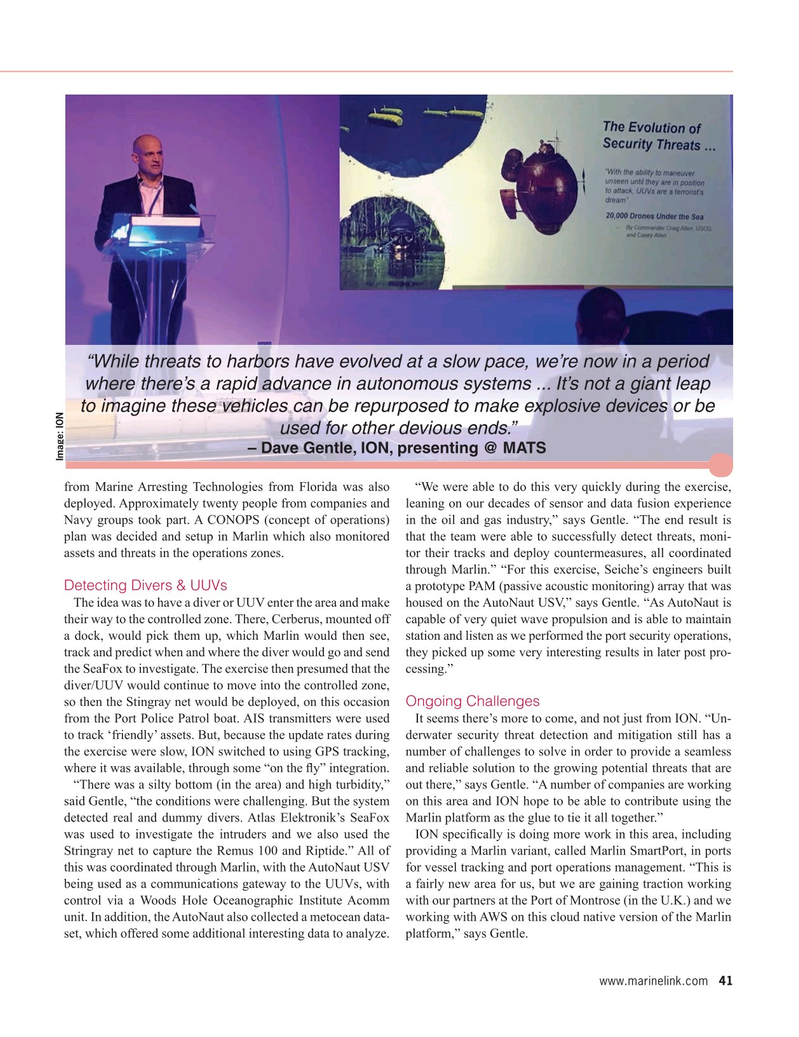
Page 41: of Maritime Reporter Magazine (October 2020)
Shipping & Port Annual
Read this page in Pdf, Flash or Html5 edition of October 2020 Maritime Reporter Magazine
“While threats to harbors have evolved at a slow pace, we’re now in a period where there’s a rapid advance in autonomous systems ... It’s not a giant leap to imagine these vehicles can be repurposed to make explosive devices or be used for other devious ends.” g Image: ION – Dave Gentle, ION, presenting @ MATS from Marine Arresting Technologies from Florida was also “We were able to do this very quickly during the exercise, deployed. Approximately twenty people from companies and leaning on our decades of sensor and data fusion experience
Navy groups took part. A CONOPS (concept of operations) in the oil and gas industry,” says Gentle. “The end result is plan was decided and setup in Marlin which also monitored that the team were able to successfully detect threats, moni- assets and threats in the operations zones. tor their tracks and deploy countermeasures, all coordinated through Marlin.” “For this exercise, Seiche’s engineers built
Detecting Divers & UUVs a prototype PAM (passive acoustic monitoring) array that was
The idea was to have a diver or UUV enter the area and make housed on the AutoNaut USV,” says Gentle. “As AutoNaut is their way to the controlled zone. There, Cerberus, mounted off capable of very quiet wave propulsion and is able to maintain a dock, would pick them up, which Marlin would then see, station and listen as we performed the port security operations, track and predict when and where the diver would go and send they picked up some very interesting results in later post pro- the SeaFox to investigate. The exercise then presumed that the cessing.” diver/UUV would continue to move into the controlled zone, so then the Stingray net would be deployed, on this occasion
Ongoing Challenges from the Port Police Patrol boat. AIS transmitters were used It seems there’s more to come, and not just from ION. “Un- to track ‘friendly’ assets. But, because the update rates during derwater security threat detection and mitigation still has a the exercise were slow, ION switched to using GPS tracking, number of challenges to solve in order to provide a seamless where it was available, through some “on the ? y” integration. and reliable solution to the growing potential threats that are “There was a silty bottom (in the area) and high turbidity,” out there,” says Gentle. “A number of companies are working said Gentle, “the conditions were challenging. But the system on this area and ION hope to be able to contribute using the detected real and dummy divers. Atlas Elektronik’s SeaFox Marlin platform as the glue to tie it all together.” was used to investigate the intruders and we also used the ION speci? cally is doing more work in this area, including
Stringray net to capture the Remus 100 and Riptide.” All of providing a Marlin variant, called Marlin SmartPort, in ports this was coordinated through Marlin, with the AutoNaut USV for vessel tracking and port operations management. “This is being used as a communications gateway to the UUVs, with a fairly new area for us, but we are gaining traction working control via a Woods Hole Oceanographic Institute Acomm with our partners at the Port of Montrose (in the U.K.) and we unit. In addition, the AutoNaut also collected a metocean data- working with AWS on this cloud native version of the Marlin set, which offered some additional interesting data to analyze. platform,” says Gentle. www.marinelink.com 41
MR #10 (34-49).indd 41 10/6/2020 9:32:03 AM

 40
40

 42
42
